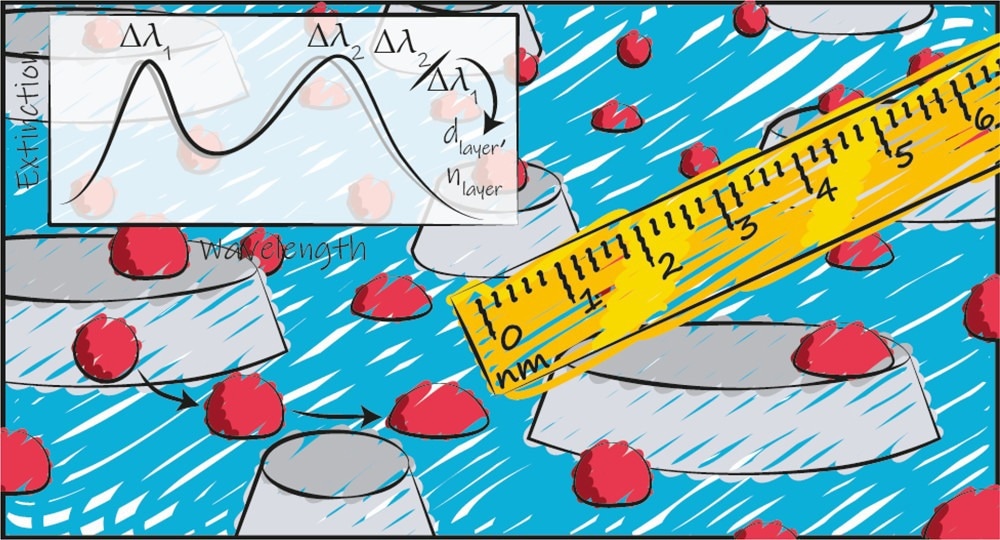Measuring changes in the shape and size of nanobiological objects and layers in real-time is critical for optimizing their performance. Optical sensing involves label-free operation and has high throughput and sensitivity. However, state-of-the-art techniques require the measurement of multiple parameters to unravel conformational or thickness changes in biomolecular layers.

Study: Time-Resolved Thickness and Shape-Change Quantification using a Dual-Band Nanoplasmonic Ruler with Sub-Nanometer Resolution. Image Credit: ACS Nano (2022), Nugroho, F.A.A et al. (2022)
An article published in ACS Nano presented dual-band nanoplasmonic rulers composed of plasmonic nanoparticles in mixed arrays with spectrally separated resonance peaks. Based on model experiments and electrodynamic simulations, these nanorulers enabled concurrent measurements of the variation in the refractive index and thickness of heterogeneous layers with uniform surface and sub-nanometer resolution.
Additionally, changes in the shape of the nanostructure can be tracked by quantifying the degree of deformation in lipid vesicles at a stage prior to rupture. Thus, the study presents a convenient route for multimodal nanoplasmonic optical sensing.
Characterization of Biological Nanosystems Using Nanoplasmonic Rulers
Nanotechnology and nanoscience rely significantly on the accurate measurement of shape and size, which determine the functionalities and properties of nanomaterials in life science. Moreover, because nanoscopic biological species and their functionality are the root cause of many diseases, precise characterization of these entities helps develop advanced therapeutic systems and tools.
Although various analytical techniques have been established to characterize nanoscopic biological entities, most of them have limitations. Within this framework, plasmon-based sensors are excellent tools for the label-free detection of small biomolecules. An interesting group of such sensors is nanoplasmonic rulers, which rely on plasmon hybridization upon modification of their morphology to sense nanoscale distances.
Many optical sensing techniques have been explored in the past few decades to measure the presence or changes in the biomolecular layer on the surface of a sensor via changes in the refractive index among interfacial layers. Thus, it provides label-free, sensitive, and real-time detection with a simple operation and high throughput.
Localized surface plasmon resonance (LSPR)-based sensors can serve as plasmonic nanorulers, enabling the measurement of the thickness of biological nanoparticles
Plasmonic nanorulers have some distinct advantages over the fluorescence resonance energy transfer (FRET) technique which is traditionally used for distance measurement at the nanoscale level. However, a major prerequisite for applying plasmonic nanorulers is the systematic calibration and standardization of the spectral shift as a function of the interparticle separation.
Dual-Band Nanoplasmonic Ruler and Its Application
In the present work, plasmonic nanorulers were introduced to accurately determine the layer thickness of a biological entity with a sub-nanometer resolution. The dual-band plasmonic nanorulers were composed of plasmonic nanoantennas with two mixed populations in terms of size, resulting in two independent LSPR peaks in the extinction spectrum.
The resonating antennas created a short-range evanescent, which enabled the accurate determination of the refractive index and thickness in real-time in the layer thickness range of 10 nanometers.
A customized version of hole-mask colloidal lithography was employed to demonstrate the potential of the nanofabricated plasmonic dual-band nanorulers to measure and resolve the thickness changes in systems, including atomic layer deposition of an alumina (Al2O3) film in air, adsorption of silica (SiO2) nanospheres onto a supported lipid bilayer (SLB), and planar SLB on SiO2 liquid. Thus, plasmonic nanorulers stand out amongst other optical nanorulers with their label-free, real-time, and high-throughput traits.
Moreover, the nanorulers of the present work were used to quantify the shape changes in the lipid vesicles adsorbed during the formation of SLB. Thus, their direct information on the degree of deformation of the lipid vesicles was obtained prior to their rupture.
Conclusion
To summarize, dual-band plasmonic nanorulers were developed to determine the changes in the refractive index and thickness of arbitrary multilayers and the shape of the deposited nanoparticles with sub-nanometer resolution.
Herein, the plasmonic nanosensor surfaces were composed of two differently sized nanoantennas that probe the adlayers independently and conjointly to reveal the sensor readout from the change in the thickness of the adlayers, refractive index, and shape.
The accuracy of the plasmonic nanorulers was corroborated by measuring the thickness changes in the systems in air and liquid environments. The nanorulers presented in this work are advantageous over other optical nanorulers owing to their real-time, label-free, and high-throughput characteristics. Thus, the plasmonic nanorulers address the concerns related to the confirmation and size of nanoscopic biological entities.
Reference
Nugroho, F.A.A et al. (2022). Time-Resolved Thickness and Shape-Change Quantification using a Dual-Band Nanoplasmonic Ruler with Sub-Nanometer Resolution. ACS Nano. https://pubs.acs.org/doi/10.1021/acsnano.2c04948
Disclaimer: The views expressed here are those of the author expressed in their private capacity and do not necessarily represent the views of AZoM.com Limited T/A AZoNetwork the owner and operator of this website. This disclaimer forms part of the Terms and conditions of use of this website.